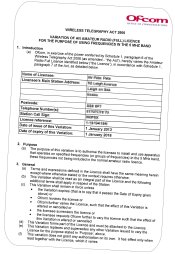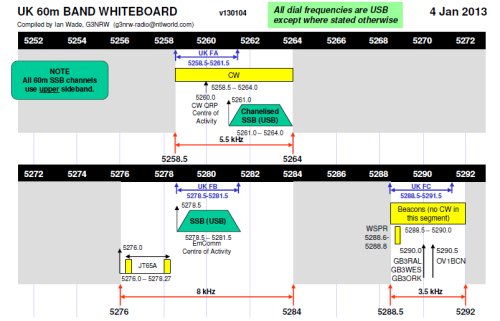On the first of January 2013, Full licence-holders were allowed access to 5MHz by Ofcom. At the time, this was an experimental release requiring an NoV. Since 2015, this allocation has been made available to all Full licence holders, but there are some restrictions. This page offers a basic introduction to using the the 5MHz , band, aimed that those not familiar with this allocation.
What is 5MHz?
It’s on the 60 metre band, which is a band that you won’t find mentioned in the standard amateur radio licence. Here’s what you need to know:
- It’s only available to Full licence holders
- Off-the-shelf radios don’t allow you to transmit on the 60 metre, as it’s not normally a UK band, although you should be able to listen. To transmit, you will need to modify your radio to unlock the restriction
- The primary user of the band in the UK is the MoD
- You are restricted to 100 watts (or 200 watts erp) with antenna no more than 20 metres from ground level
- There’s only a small selection of frequencies between 5.2585 and 5.4065MHz, and they are divided into 11 small chunks
- You’re only allowed to operate at the Station Address or at a temporary location (no mobile, maritime mobile or Alternate address operation)
- You need to be near a phone, so you can be contacted if causing interference to a primary user
What’s on 5MHz
As mentioned above, there’s only a very small number of slots on the 5MHz allocation. From what I’ve heard, this band is not being used for “rag chews”, and certainly not for contesting. Listening in, there’s much discussion of propagation of this band, and multiple nets, including the popular Sunset Net. There are also various beacons, occasional contacts with military stations, and use CW as well as various data modes.

Applying to use 5MHz
When this allocation first became available in January 2013, you were required to take out an NoV. Now it’s part of the allocation for Full UK licence holders, so no need for an NoV.
Using 5MHz
The band is very good for Inter-G working (working with stations in the UK), but other European and US stations have been heard. Note that many other countries don’t have access to this band, or may be allowed to use different frequencies within this band. It is not OK to contact another amateur on a frequency other than those detailed in your licence.
It’s also important to not stray out of band. The frequencies are very tight, and of low bandwidth. You’ll typically use USB, and you’ll have to allow +3KHz bandwidth for voice. For example, to ensure you don’t stray beyond 5.4065MHz, you can’t set your dial frequency above 5.4035MHz
Check the RSGB Band Plan for details of where you can transmit. We’d also recommend you get a PDF copy of the UK 60m Band Utilization Chart, created by Ian G3NRW, which gives a clear idea where you can transmit.

5MHz RSGB News
If you’re interested in hearing the 5MHz amateur allocation active, then the time to listen is Sunday afternoon. As you may be aware, there is a weekly reading of news from the RSGB on various bands from various locations. There is a reading of the news on 5MHz weekly, followed by a Net. Details as follows:
- Frequency: 5.4035MHz USB
- Callsign: GB2RS
- Reader: Steve G4HPE in Hertfordshire
The after-news Net today (Sunday the 13th Jan 2013) was very well attended – the long list of attendees seemed to surprise newsreader Steve G4HPE. Stations received here in Essex by Pete M0PSX today were as follows (with sig rpt in brackets):
- Steve G4HPE (59+), Tony G8DQZ (58), Clem G0APM (59+), Jim GM4NTL (37), George G4ZWA (58), Wolfgang G4SSX (59), Mike G4HOL (49), Alan G3IOE (27), Sid M0SRS (49), John G3ENI (58), Bob G7JHW (48), Graham Oz1QV (59+) and Terry G0LGF (58). There were two or three other stations but hard to read.
- Also at the end of the net, the military station 91A (Nine One Alpha) appeared to take reception reports, and was worked by a couple of amateur stations.
More on the 5MHz allocation
Here are a few handy links I’ve picked up along the way:
- RSGB 5MHz Band Plan
- Five Megs Yahoo Reflector – Discussion (sometimes heated) on the UK amateur use of 5MHz
- UK 60m Band Utilization Chart – Download a handy PDF, created by Ian G3NRW
Summary
Hopefully, this gives you a brief introduction to 5MHz. We’ll update this article with anything new or interesting we discover…


Good introduction to how things are, but perhaps time for updating and hopes for WRC15.
Regards, Mike, G4HOL
Thank you for thebinformation above ( G0CFI )
Just a quick note to tell you that for some time now the 5 Mhz GB2RS News Transmission has been taking place on Sundays at 1600 hrs local on a frequency of 5398.5 kHz USb
Cheers
Paul Gaskell G4MWO
Member of 5 MHz GB2RS Newsreading Team
Editor, The 5 MHz Newsletter
http://tinyurl.com/m9a9puy
(archive –
Worldwide 5 MHz Amateur Allocations Chart
http://tinyurl.com/pjhd943
Wikipedia 60 Meter Band page
http://en.wikipedia.org/wiki/60-meter_band
The RSGB 5 MHz Section can now be found at
http://rsgb.org/main/operating/band-plans/hf/5mhz/
UPDATED ADVICE
OFCOM has now automatically incorporated the 5MHz Band allocation within the UK Full Licence, therefore a Notice of Variation (NoV) is no longer required. See: Amateur Radio Licence – Guidance for licensees – April 2016 – Schedule 1, Note g. AND your updated Licence Conditions.
Transmission on 5MHz is only permitted from a fixed location within UK. The definitions are: (a) “The Licensee shall operate the Station only at the Main Station Address or at a Temporary Location within the United Kingdom”, where Temporary Location is defined as: “a fixed location in the United Kingdom which is not the Main Station Address or an Alternative Address”.
Therefore mobile, and maritime mobile, transmission is not permitted. You may suffix your call sign with /A or /P if you wish (not compulsory), provided, of course, your station is in a fixed position.
Regards to All,
Iain M1OOO